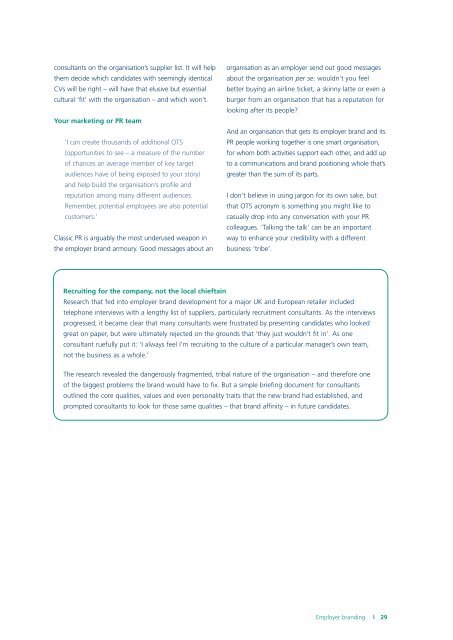Employer branding A no-nonsense approach - CIPD
Employer branding A no-nonsense approach - CIPD
Employer branding A no-nonsense approach - CIPD
Create successful ePaper yourself
Turn your PDF publications into a flip-book with our unique Google optimized e-Paper software.
consultants on the organisation’s supplier list. It will help<br />
them decide which candidates with seemingly identical<br />
CVs will be right – will have that elusive but essential<br />
cultural ‘fit’ with the organisation – and which won’t.<br />
Your marketing or PR team<br />
‘I can create thousands of additional OTS<br />
(opportunities to see – a measure of the number<br />
of chances an average member of key target<br />
audiences have of being exposed to your story)<br />
and help build the organisation’s profile and<br />
reputation among many different audiences.<br />
Remember, potential employees are also potential<br />
customers.’<br />
Classic PR is arguably the most underused weapon in<br />
the employer brand armoury. Good messages about an<br />
organisation as an employer send out good messages<br />
about the organisation per se: wouldn’t you feel<br />
better buying an airline ticket, a skinny latte or even a<br />
burger from an organisation that has a reputation for<br />
looking after its people?<br />
And an organisation that gets its employer brand and its<br />
PR people working together is one smart organisation,<br />
for whom both activities support each other, and add up<br />
to a communications and brand positioning whole that’s<br />
greater than the sum of its parts.<br />
I don’t believe in using jargon for its own sake, but<br />
that OTS acronym is something you might like to<br />
casually drop into any conversation with your PR<br />
colleagues. ‘Talking the talk’ can be an important<br />
way to enhance your credibility with a different<br />
business ‘tribe’.<br />
Recruiting for the company, <strong>no</strong>t the local chieftain<br />
Research that fed into employer brand development for a major UK and European retailer included<br />
telephone interviews with a lengthy list of suppliers, particularly recruitment consultants. As the interviews<br />
progressed, it became clear that many consultants were frustrated by presenting candidates who looked<br />
great on paper, but were ultimately rejected on the grounds that ‘they just wouldn’t fit in’. As one<br />
consultant ruefully put it: ‘I always feel I’m recruiting to the culture of a particular manager’s own team,<br />
<strong>no</strong>t the business as a whole.’<br />
The research revealed the dangerously fragmented, tribal nature of the organisation – and therefore one<br />
of the biggest problems the brand would have to fix. But a simple briefing document for consultants<br />
outlined the core qualities, values and even personality traits that the new brand had established, and<br />
prompted consultants to look for those same qualities – that brand affinity – in future candidates.<br />
<strong>Employer</strong> <strong>branding</strong>

















